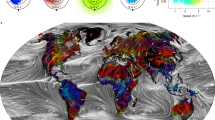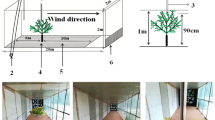Abstract
Long-distance dispersal (LDD) is central to species expansion following climate change, re-colonization of disturbed areas and control of pests1,2,3,4,5,6,7,8. The current paradigm is that the frequency and spatial extent of LDD events are extremely difficult to predict9,10,11,12. Here we show that mechanistic models coupling seed release and aerodynamics with turbulent transport processes provide accurate probabilistic descriptions of LDD of seeds by wind. The proposed model reliably predicts the vertical distribution of dispersed seeds of five tree species observed along a 45-m high tower in an eastern US deciduous forest. Simulations show that uplifting above the forest canopy is necessary and sufficient for LDD, hence, they provide the means to define LDD quantitatively rather than arbitrarily. Seed uplifting probability thus sets an upper bound on the probability of long-distance colonization. Uplifted yellow poplar seeds are on average lighter than seeds at the forest floor, but also include the heaviest seeds. Because uplifting probabilities are appreciable (as much as 1–5%), and tree seed crops are commonly massive, some LDD events will establish individuals that can critically affect plant dynamics on large scales.
This is a preview of subscription content, access via your institution
Access options
Subscribe to this journal
Receive 51 print issues and online access
$199.00 per year
only $3.90 per issue
Buy this article
- Purchase on Springer Link
- Instant access to full article PDF
Prices may be subject to local taxes which are calculated during checkout



Similar content being viewed by others
References
Gregory, P. H. The Microbiology of the Atmosphere 2nd edn (Wiley, New York, 1973)
Pasquill, F. & Smith, F. B. Atmospheric Diffusion 3rd edn (Ellis Horwood, Chichester, 1983)
Leonard, K. J. & Fry, W. E. (eds) Plant Disease Epidemiology: Population Dynamics and Management (MacMillan, New York, 1986)
Levin, S. A. The problem of pattern and scale in ecology. Ecology 73, 1943–1967 (1992)
Clark, J. S. et al. Reid's paradox of rapid plant migration: dispersal theory and interpretation of paleoecological records. Bioscience 48, 13–24 (1998)
Cain, M. L., Milligan, B. G. & Strand, A. E. Long-distance seed dispersal in plant populations. Am. J. Bot. 87, 1217–1227 (2000)
Nathan, R. & Muller-Landau, H. C. Spatial patterns of seed dispersal, their determinants and consequences for recruitment. Trends Ecol. Evol. 15, 278–285 (2000)
Nathan, R. in Encyclopedia of Biodiversity Vol. II (ed. Levin, S. A.) 127–152 (Academic Press, San Diego, 2001)
Greene, D. F. & Johnson, E. A. Long-distance wind dispersal of tree seeds. Can. J. Bot. 73, 1036–1045 (1995)
Higgins, S. I. & Richardson, D. M. Predicting plant migration rates in a changing world: the role of long-distance dispersal. Am. Nat. 153, 464–475 (1999)
Bullock, J. M. & Clarke, R. T. Long distance seed dispersal by wind: measuring and modelling the tail of the curve. Oecologia 124, 506–521 (2000)
Clark, J. S., Lewis, M. & Horvath, L. Invasion by extremes: population spread with variation in dispersal and reproduction. Am. Nat. 157, 537–554 (2001)
Ridley, H. N. The Dispersal of Plants Throughout the World (Reeve, Ashford, 1930)
van der Pijl, L. Principles of Dispersal in Higher Plants 3rd edn (Springer, Berlin, 1982)
Ridley, H. N. On the dispersal of seeds by wind. Ann. Bot. Lond. 19, 351–363 (1905)
Webber, M. L. Fruit dispersal. Malayan Forester 3, 18–19 (1934)
Willson, M. F. Dispersal mode, seed shadows, and colonization patterns. Vegetatio 107/108, 261–280 (1993)
Clark, J. S., Macklin, E. & Wood, L. Stages and spatial scales of recruitment limitation in southern Appalachian forests. Ecol. Monogr. 68, 213–235 (1998)
Okubo, A. & Levin, S. A. A theoretical framework for data analysis of wind dispersal of seeds and pollen. Ecology 70, 329–338 (1989)
Nathan, R., Safriel, U. N. & Noy-Meir, I. Field validation and sensitivity analysis of a mechanistic model for tree seed dispersal by wind. Ecology 82, 374–388 (2001)
Hsieh, C. I., Katul, G. G., Schieldge, J., Sigmon, J. T. & Knoerr, K. K. The Lagrangian stochastic model for fetch and latent heat flux estimation above uniform and nonuniform terrain. Water Resour. Res. 33, 427–438 (1997)
Katul, G. G. & Albertson, J. D. An investigation of higher-order closure models for a forested canopy. Boundary-Lay. Meteorol. 89, 47–74 (1998)
Higgins, S. I., Nathan, R. & Cain, M. L. Are long-distance dispersal events in plants usually caused by nonstandard means of dispersal? Ecology (submitted)
Katul, G. G., Geron, C. D., Hsieh, C. I., Vidakovic, B. & Guenther, A. B. Active turbulence and scalar transport near the forest–atmosphere interface. J. Appl. Meteor. 37, 1533–1546 (1998)
Burns, R. M. & Honkala, B. H. Silvics of North America. Agricultural Handbook 654 (US Department of Agriculture, Washington, DC, 1990)
De Steven, D. Experiments on mechanisms of free establishment in old-field succession: seedling survival and growth. Ecology 72, 1076–1088 (1991)
Nathan, R. The challenges of studying dispersal. Trends Ecol. Evol. 16, 481–483 (2001)
Horn, H. S., Nathan, R. & Kaplan, S. R. Long-distance dispersal of tree seeds by wind. Ecol. Res. 16, 877–885 (2001)
Finnigan, J. Turbulence in plant canopies. Ann. Rev. Fluid Mech. 32, 519–571 (2000)
Monin, A. S. & Yaglom, A. M. in Statistical Fluid Mechanics Vol. 1 (ed. Lumley, J.) 209–218 (MIT Press, Cambridge, Massachusetts, 1971)
Acknowledgements
We thank M. Siqueira, C.-T. Lai, C.-I. Hsieh, I. Ibanez, S. LaDeau, B. Poulter, D. Ellsworth, J. Chave and O. Nathan for their help with data collection, and M. Cain for his comments. This study is supported by the National Science Foundation and the US Department of Energy through their Integrative Biology and Neuroscience, Terrestrial Carbon Processes, and National Institute for Global Environmental Change (South-East Regional Center) programmes.
Author information
Authors and Affiliations
Corresponding author
Ethics declarations
Competing interests
The authors declare that they have no competing financial interests.
Rights and permissions
About this article
Cite this article
Nathan, R., Katul, G., Horn, H. et al. Mechanisms of long-distance dispersal of seeds by wind. Nature 418, 409–413 (2002). https://doi.org/10.1038/nature00844
Received:
Accepted:
Issue Date:
DOI: https://doi.org/10.1038/nature00844
This article is cited by
-
Dispersal of juvenile Barrow’s goldeneyes (Bucephala islandica) mirrors that of breeding adults
Movement Ecology (2023)
-
Bioclimatic atlas of the terrestrial Arctic
Scientific Data (2023)
-
Visual anemometry for physics-informed inference of wind
Nature Reviews Physics (2023)
-
Seed Dispersal in Pines (Pinus)
The Botanical Review (2023)
-
Genetic diversity and structure of seed pools in an old planted Pinus thunbergii population and seed collection strategy for gene preservation
Tree Genetics & Genomes (2023)
Comments
By submitting a comment you agree to abide by our Terms and Community Guidelines. If you find something abusive or that does not comply with our terms or guidelines please flag it as inappropriate.



